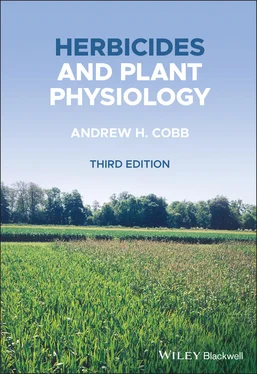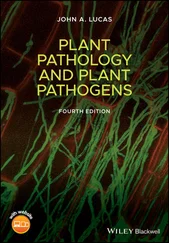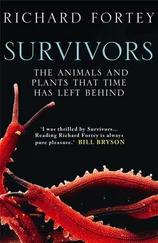Andrew H. Cobb - Herbicides and Plant Physiology
Здесь есть возможность читать онлайн «Andrew H. Cobb - Herbicides and Plant Physiology» — ознакомительный отрывок электронной книги совершенно бесплатно, а после прочтения отрывка купить полную версию. В некоторых случаях можно слушать аудио, скачать через торрент в формате fb2 и присутствует краткое содержание. Жанр: unrecognised, на английском языке. Описание произведения, (предисловие) а так же отзывы посетителей доступны на портале библиотеки ЛибКат.
- Название:Herbicides and Plant Physiology
- Автор:
- Жанр:
- Год:неизвестен
- ISBN:нет данных
- Рейтинг книги:5 / 5. Голосов: 1
-
Избранное:Добавить в избранное
- Отзывы:
-
Ваша оценка:
- 100
- 1
- 2
- 3
- 4
- 5
Herbicides and Plant Physiology: краткое содержание, описание и аннотация
Предлагаем к чтению аннотацию, описание, краткое содержание или предисловие (зависит от того, что написал сам автор книги «Herbicides and Plant Physiology»). Если вы не нашли необходимую информацию о книге — напишите в комментариях, мы постараемся отыскать её.
Discover the latest developments in herbicide and weed biology Herbicides and Plant Physiology,
Arabidopsis
Herbicides and Plant Physiology
Herbicides and Plant Physiology — читать онлайн ознакомительный отрывок
Ниже представлен текст книги, разбитый по страницам. Система сохранения места последней прочитанной страницы, позволяет с удобством читать онлайн бесплатно книгу «Herbicides and Plant Physiology», без необходимости каждый раз заново искать на чём Вы остановились. Поставьте закладку, и сможете в любой момент перейти на страницу, на которой закончили чтение.
Интервал:
Закладка:
Table of Contents
1 Cover
2 Title Page
3 Copyright Page
4 Preface References
5 Chapter 1: An Introduction to Weed Biology 1.1 Introduction 1.2 Distribution 1.3 The importance of weeds 1.4 Problems caused by weeds 1.5 Biology of weeds 1.6 A few examples of problem weeds 1.7 Positive attributes of weeds 1.8 The ever‐changing weed spectrum 1.9 Weed control References
6 Chapter 2: Herbicide Discovery and Development 2.1 Introduction 2.2 Markets 2.3 Prospects 2.4 Environmental impact and relative toxicology 2.5 Chemophobia 2.6 The search for novel active ingredients 2.7 The search for novel target sites 2.8 Mode of action studies 2.9 The role of natural chemistry 2.10 Recent developments 2.11 A lower limit for rates of herbicide application? References
7 Chapter 3: Herbicide Uptake and Movement 3.1 Introduction 3.2 The cuticle as a barrier to foliar uptake 3.3 Physicochemical aspects of foliar uptake 3.4 Herbicide formulation 3.5 Uptake by roots from soil 3.6 Herbicide translocation from roots to shoots 3.7 A case study: the formulation of acids 3.8 The formulation of glyphosate 3.9 Further developments References
8 Chapter 4: Herbicide Selectivity and Metabolism 4.1 Introduction 4.2 General principles 4.3 Herbicide safeners and synergists References
9 Chapter 5: Herbicides that Inhibit Photosynthesis 5.1 Introduction 5.2 Photosystems 5.3 Inhibition at Photosystem II 5.4 Photodamage and repair of Photosystem II 5.5 Structures and uses of Photosystem II inhibitors 5.6 Interference with electron flow at Photosystem I 5.7 RuBisCo activase 5.8 How treated plants die 5.9 Chlorophyll fluorescence 5.10 Inhibition of photosynthetic carbon reduction in C4 plants References
10 Chapter 6: Inhibitors of Pigment Biosynthesis 6.1 Introduction: structures and functions of photosynthetic pigments 6.2 Inhibition of chlorophyll biosynthesis 6.3 Inhibition of carotenoid biosynthesis 6.4 Inhibition of plastoquinone biosynthesis 6.5 How treated plants die 6.6 Selectivity and metabolism 6.7 Summary References
11 Chapter 7: Auxin‐type Herbicides 7.1 Introduction 7.2 Structures and uses of auxin‐type herbicides 7.3 Auxin, a natural plant growth regulator 7.4 Biosynthesis and metabolism of auxins 7.5 Auxin receptors, gene expression and herbicides 7.6 Signal transduction 7.7 Auxin transport 7.8 Resistance to auxin‐type herbicides 7.9 An ‘auxin overdose’ 7.10 How treated plants die 7.11 Selectivity and metabolism References
12 Chapter 8: Inhibitors of Lipid Biosynthesis 8.1 Introduction 8.2 Structures and uses of graminicides 8.3 Inhibition of lipid biosynthesis 8.4 Activity of graminicides in mixtures 8.5 How treated plants die 8.6 Plant oxylipins: lipids with key roles in plant defence and development 8.7 Selectivity References
13 Chapter 9: The Inhibition of Amino Acid Biosynthesis 9.1 Introduction 9.2 Overview of amino acid biosynthesis in plants 9.3 Inhibition of glutamine synthase 9.4 Inhibition of aromatic amino acid biosynthesis 9.5 Inhibition of branch‐chain amino acid biosynthesis 9.6 Inhibition of histidine biosynthesis References
14 Chapter 10: The Disruption of Cell Division 10.1 Introduction 10.2 The cell cycle 10.3 Control of the cell cycle 10.4 Microtubule structure and function 10.5 Herbicidal interference with microtubules 10.6 Selectivity References
15 Chapter 11: The Inhibition of Cellulose Biosynthesis 11.1 Introduction 11.2 Cellulose biosynthesis 11.3 Cellulose biosynthesis inhibitors 11.4 How treated plants die 11.5 Selectivity References
16 Chapter 12: Plant Kinases, Phosphatases and Stress Signalling 12.1 Introduction 12.2 Plant kinases 12.3 Plant phosphatases 12.4 Cyclin‐dependent kinases and plant stress 12.5 Post‐translational modification of proteins References
17 Chapter 13: Herbicide Resistance 13.1 Introduction 13.2 Definition of herbicide resistance 13.3 How resistance occurs 13.4 A chronology of herbicide resistance 13.5 Mechanisms of herbicide resistance 13.6 Case study – black‐grass ( A. myosuroides Huds) 13.7 Strategies for the control of herbicide‐resistant weeds 13.8 The future development of herbicide resistance References
18 Chapter 14: Herbicide‐tolerant Crops 14.1 Introduction 14.2 History of genetically modified, herbicide‐tolerant crops 14.3 How genetically modified crops are produced 14.4 Genetically engineered herbicide tolerance to glyphosate 14.5 Genetically modified herbicide tolerance to glufosinate 14.6 Genetically modified herbicide tolerance to bromoxynil 14.7 Genetically modified herbicide tolerance to sulphonylureas 14.8 Genetically modified herbicide tolerance to 2,4‐D 14.9 Genetically modified herbicide tolerance to fops and dims 14.10 Genetically modified herbicide tolerance to phytoene desaturase inhibitors 14.11 Herbicide tolerance owing to genetic engineering of enhanced metabolism 14.12 Herbicide tolerance through means other than genetic modification 14.13 Gene editing 14.14 Economic, environmental and human health benefits from the adoption of GM technology 14.15 Gene stacking 14.16 Will the rise of glyphosate be inevitably followed by a fall? 14.17 Why is there so much opposition to GM technology? 14.18 Future prospects References
19 Chapter 15: Further Targets for Herbicide Development 15.1 Introduction 15.2 Protein turnover 15.3 The promotion of ageing in weeds? 15.4 Herbicide leads at the apicoplast 15.5 Control of seed germination and dormancy 15.6 Natural products as leads for new herbicides References
20 Glossary
21 Index
22 End User License Agreement
List of Tables
1 Chapter 1 Table 1.1 Important plant families which contain both the major crops and t... Table 1.2 Problems caused by weeds. Table 1.3 Examples of yield losses owing to weeds. Table 1.4 Estimated percentage crop losses owing to weeds, 1988–90 (from Oe... Table 1.5 Relative competitive abilities of a number of common weeds found ... Table 1.6 Some examples of weeds as hosts for crop pests and diseases. Table 1.7 Growth strategies of plants. Table 1.8 The ‘successful’ weed. Table 1.9 Seed production by a number of common arable weeds and wheat. Table 1.10 Photosynthetic pathway of the world’s 10 worst weeds. Table 1.11 Ranking of the competitive effects of selected weed species and ... Table 1.12 Main broadleaf weeds and grass weeds present in 2359 winter cere...
2 Chapter 2 Table 2.1 Estimated annual sales of the four major agrochemical companies, ... Table 2.2 Leading herbicides in 2015, according to sales for key crops (Phi... Table 2.3 Typical tests required for the environmental acceptability of pes... Table 2.4 Toxicity of some herbicides and common chemicals to rats. Table 2.5 Carcinogens in food. Table 2.6 Costs for the development of an agricultural chemical.Table 2.7 Existing targets for herbicide action.Table 2.8A Thirty‐three additional herbicide targets demonstrated in vitro ....Table 2.8B Twenty‐six additional patented herbicide targets.Table 2.9 Herbicide systemicity and log K ow.Table 2.10 Target sites of some natural compounds that inhibit plant growth...Table 2.11 Some new herbicides developed since 2000.
3 Chapter 3Table 3.1 Most common epicuticular wax components (after Holloway, 1993).Table 3.2 Variations in epicuticular lipid classes. Values are percentages ...Table 3.3 Common cutin monomers, normally C16 and C18, of fatty acids.Table 3.4 Herbicide formulations.Table 3.5 Estimated physical properties of ethoxylated alcohols and allyl p...Table 3.6 Metabolism of 2,4‐D butyl ester and systemicity of its metabolite...Table 3.7 Amine cations of phenoxyalkanoic acid amine salts.
4 Chapter 4Table 4.1 Examples of some herbicides metabolised by glutathione S ‐transfera...Table 4.2 Generalised effect of each phase of metabolism on herbicide activ...Table 4.3 Herbicide safeners available as commercial products.
Читать дальшеИнтервал:
Закладка:
Похожие книги на «Herbicides and Plant Physiology»
Представляем Вашему вниманию похожие книги на «Herbicides and Plant Physiology» списком для выбора. Мы отобрали схожую по названию и смыслу литературу в надежде предоставить читателям больше вариантов отыскать новые, интересные, ещё непрочитанные произведения.
Обсуждение, отзывы о книге «Herbicides and Plant Physiology» и просто собственные мнения читателей. Оставьте ваши комментарии, напишите, что Вы думаете о произведении, его смысле или главных героях. Укажите что конкретно понравилось, а что нет, и почему Вы так считаете.











